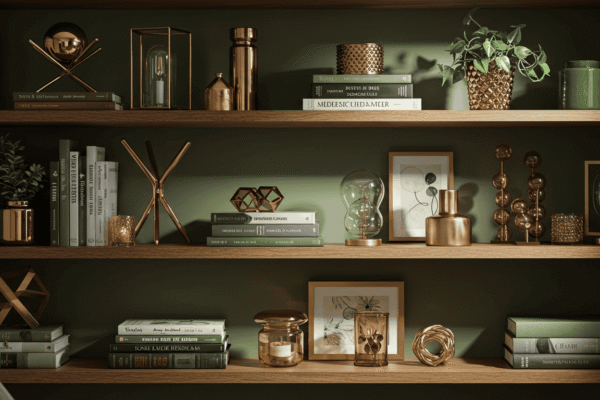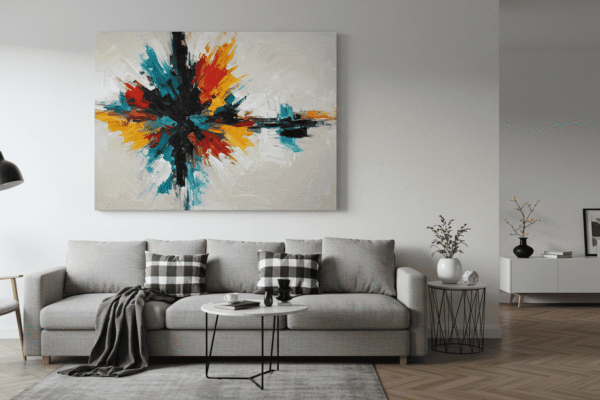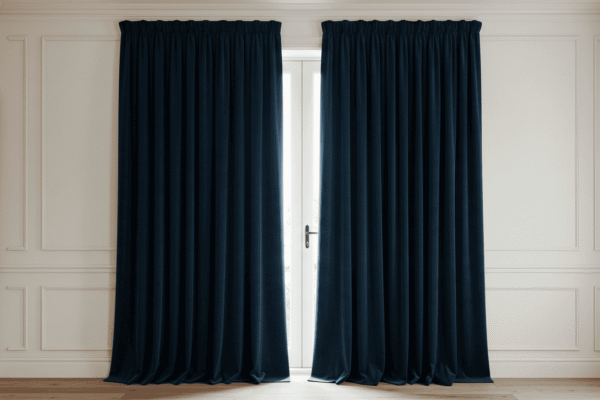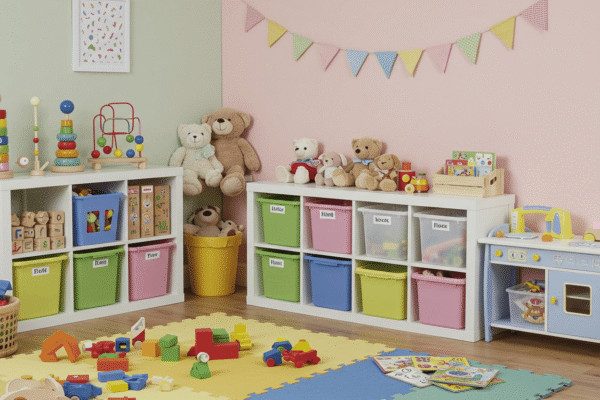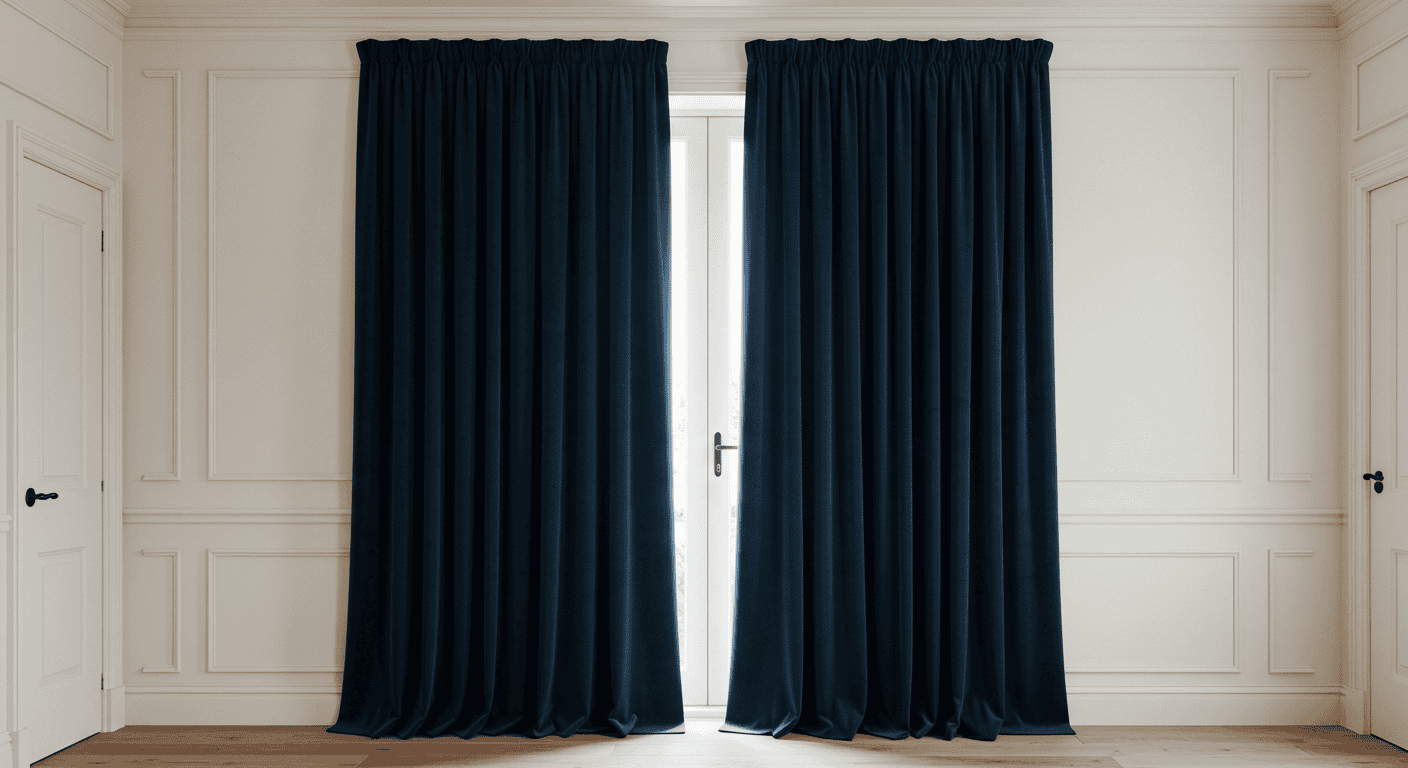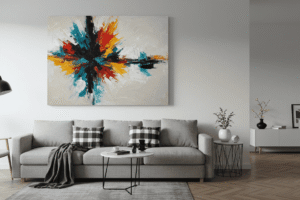Choosing the right curtains can completely transform your space—whether you’re going for cozy and intimate or bright and open. But with so many options in fabric, length, color, and style, it’s easy to feel overwhelmed. The right curtains don’t just look good—they control light, offer privacy, improve insulation, and even set the mood of a room. In this guide, we’ll walk you through everything you need to know about picking the perfect curtains for every space in your home, so your windows work just as beautifully as they look.
Why Choosing the Right Curtains Matters

Choosing the right curtains is about much more than simply picking a pretty fabric. Curtains play a vital role in shaping the overall atmosphere of your home. They serve practical purposes like enhancing privacy, improving insulation, and controlling natural light, while also contributing significantly to your interior design. Understanding why selecting the right curtains matters can help you make choices that balance function and style perfectly.
More Than Just Fabric — The Functional Role of Curtains
Curtains are essential for maintaining privacy within your living spaces, shielding your home from unwanted outside views. Beyond privacy, they contribute to your home’s comfort by offering insulation—helping keep rooms warmer in winter and cooler in summer by reducing heat transfer through windows. Additionally, curtains give you control over how much natural light enters a room, allowing you to create the perfect ambiance whether you want bright, sunlit spaces or a cozy, dimmer setting. These practical benefits make choosing the right curtains a key decision in any home improvement project.
How Curtains Influence the Look and Feel of a Room
The impact of curtains extends well beyond function; they dramatically affect the mood and visual dynamics of a room. The right curtain color and texture can enhance color harmony by complementing your existing decor or creating striking contrasts. Curtains also influence the perception of space—light, sheer fabrics can make a small room feel airy and open, while heavy, dark drapes add a sense of warmth and intimacy. Thoughtful curtain choices help set the tone of each room, transforming plain windows into integral design features.
Understanding Different Curtain Types
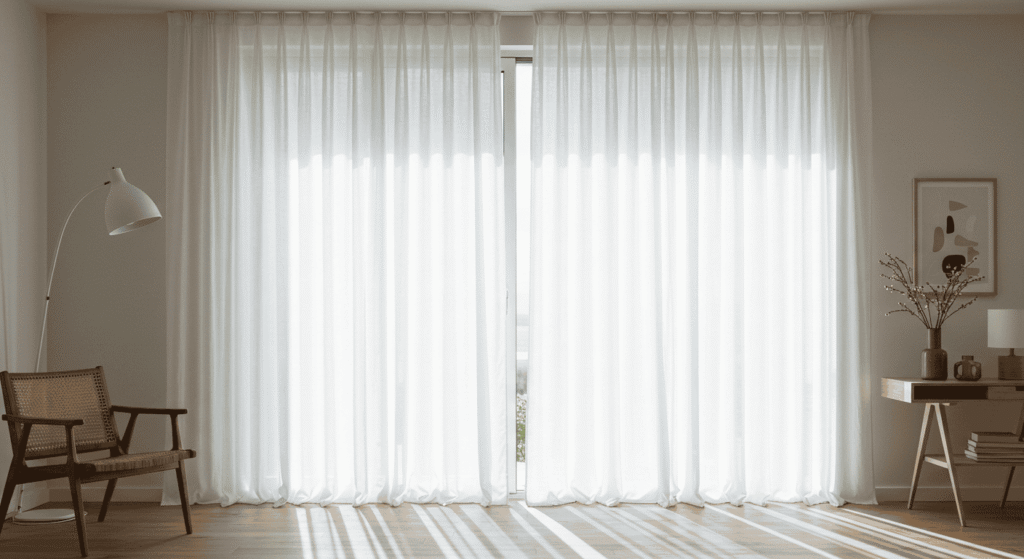
Choosing the right curtains starts with understanding the various curtain types available and how each style serves different purposes. Whether you want to create a modern look or prefer a classic touch, knowing which curtain style fits best will simplify your decision-making and help you achieve the desired aesthetic and function.
Common Styles and What They’re Best For
Different curtain styles offer unique advantages when it comes to appearance and ease of use. Here’s a breakdown of three popular types, highlighting their style level, installation ease, and ideal room applications.
Grommet vs. Rod Pocket vs. Tab Top
| Curtain Type | Style Level | Installation Ease | Best For |
|---|---|---|---|
| Grommet | Modern | Easy | Living rooms |
| Rod Pocket | Traditional | Moderate | Bedrooms |
| Tab Top | Casual | Easy | Kitchens |
- Grommet curtains feature metal rings that slide easily on curtain rods, lending a sleek, contemporary look perfect for living rooms. They’re simple to install and operate smoothly.
- Rod pocket curtains have a sewn-in pocket where the rod slides through, creating a gathered, traditional appearance. While slightly more challenging to hang, they’re ideal for cozy bedrooms.
- Tab top curtains use fabric loops to hold the rod and offer a relaxed, casual vibe suited for kitchens or informal spaces. Installation is straightforward, making them a popular choice for easy updates.
Drapes vs. Curtains vs. Sheers vs. Panels
Many people confuse these terms, but understanding the differences can improve your curtain choices. Drapes typically refer to heavier, lined fabric that offers better insulation and light blocking. Curtains are often lighter and unlined, designed mainly for decoration and light filtering. Sheers are thin, translucent fabrics that diffuse sunlight while maintaining privacy. Panels are single fabric pieces that can be mixed and matched for layering effects.
Clarifying these distinctions helps you select window treatments that align with both your style preferences and functional needs, ensuring your windows look great and perform well.
Matching Curtains with Room Function

Selecting curtains that suit the specific function of each room is essential to balance style and practicality. Different rooms have different needs when it comes to light control, privacy, and durability. Understanding these factors will help you choose curtains that enhance both the appearance and comfort of your living spaces.
Best Curtain Types for Bedrooms, Kitchens, and Living Rooms
Each room’s unique demands influence the best curtain choice. Bedrooms often require blackout curtains or heavier drapes to block light and provide privacy for restful sleep. Kitchens benefit from light filtering fabrics that let in natural light while offering some privacy, and living rooms are a versatile space where both function and design matter, making layered curtains a popular option.
Light filtering vs. blackout
Choosing between light filtering and blackout curtains depends on how much light you want to control. Light filtering curtains soften sunlight, creating a warm, inviting glow, which is ideal for living rooms and kitchens. Blackout curtains, on the other hand, block nearly all incoming light, perfect for bedrooms or media rooms where darkness is preferred.
Consider humidity and sunlight exposure
It’s important to consider environmental factors like humidity and direct sunlight exposure when selecting curtain fabrics. For example, kitchens and bathrooms require fabrics that can withstand moisture without damage or mildew, while rooms with intense sunlight benefit from fabrics that resist fading and offer UV protection.
Curtains for Small vs. Large Rooms
Choosing the right curtains also depends on the size of the room. The goal is to enhance the space without overwhelming it or making it feel cramped.
| Room Size | Curtain Tip |
|---|---|
| Small | Use light colors and full-length sheers to create an airy and open feel. |
| Large | Layer sheers with heavier drapes for visual impact and added depth. |
These tips help you make thoughtful decisions that maximize the functionality and aesthetic appeal of your window treatments according to room size.
Curtain Length, Width, and Placement — Getting the Pro Look
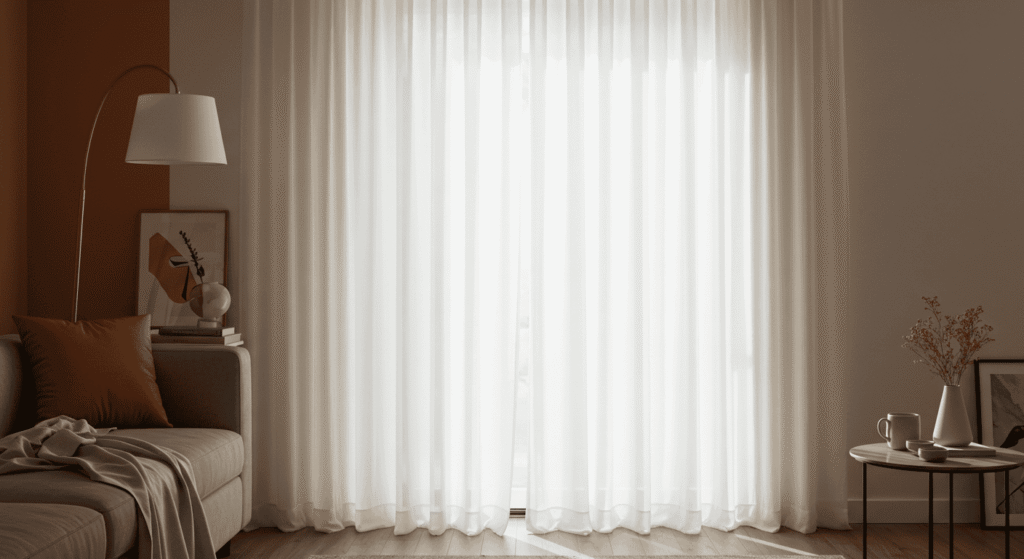
Mastering the length, width, and placement of your curtains is key to achieving a polished, professional appearance in any room. Even the most beautiful curtains can look off if they’re not sized or hung correctly. Paying attention to these details ensures your window treatments enhance the space effortlessly.
Measuring Correctly for a Custom Fit
When selecting curtains, accurate measurements are essential. You can choose between standard sizing options, which are widely available and convenient, or opt for custom curtains tailored specifically to your windows. Custom sizing is ideal for unique window dimensions or when you want an exact fit, while standard sizes often work well for common window measurements. Taking precise measurements of both width and length before purchasing helps avoid common mistakes like curtains that are too short or too narrow.
Hanging Curtains Higher and Wider
How and where you hang your curtains can dramatically affect how your windows—and the entire room—look.
How to visually “stretch” your windows
One simple trick to make windows appear larger and ceilings higher is to hang curtains slightly above the window frame and extend the curtain rod wider than the window itself. This creates an illusion of bigger windows and adds an airy, spacious feel to the room.
Rules for floor vs. sill vs. puddled lengths
Choosing the right curtain length contributes to the overall style and function. Below is a quick-reference table to help you decide:
| Style | Curtain Length | Best For |
|---|---|---|
| Sill | Just below sill | Kitchens, small windows |
| Floor | Just above floor | Most rooms |
| Puddle | 2–6″ extra length | Dramatic, elegant spaces |
- Sill-length curtains are practical and ideal for spaces like kitchens where you want to avoid fabric near the floor.
- Floor-length curtains are versatile and create a clean, tailored look in most rooms.
- Puddled curtains add a touch of luxury and drama, perfect for formal living rooms or bedrooms.
Getting these measurements and placements right will elevate your window treatments and bring a refined look to your home.
Choosing the Right Fabric and Texture
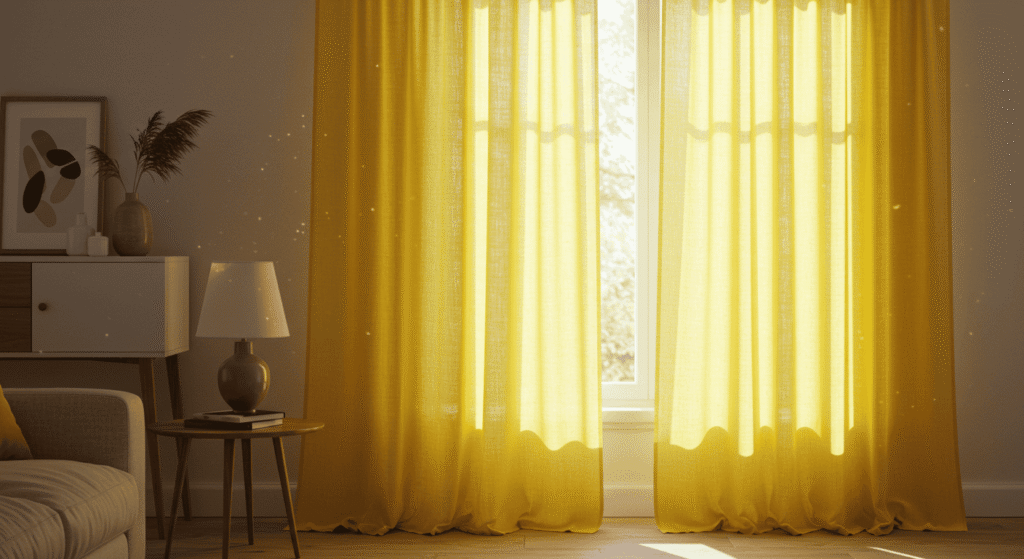
Selecting the right fabric and texture for your curtains is crucial because it affects not only the look but also the functionality and feel of your space. Different fabrics bring distinct qualities that can enhance your room’s ambiance while meeting practical needs like light control and privacy.
Fabric Options and What They Say About Your Space
There is a wide variety of fabric choices to suit different styles and environments. Linen offers a natural, relaxed vibe with a slightly textured appearance, perfect for casual and airy rooms. Cotton is versatile, durable, and easy to maintain, making it suitable for most areas. Velvet adds a luxurious, rich texture that works well in formal or cozy spaces needing extra warmth. Meanwhile, sheer fabrics provide delicate softness and allow plenty of natural light to filter through, ideal for brightening up living areas or layering with heavier curtains.
How Fabric Affects Light, Privacy, and Maintenance
Choosing the right fabric goes hand in hand with understanding how it influences light filtering, privacy, and care requirements. The texture and weight of the material determine how much sunlight is softened or blocked, how much privacy you gain, and how often the curtains will need cleaning or upkeep.
| Fabric | Light Filtering | Privacy Level | Maintenance |
|---|---|---|---|
| Sheer | High | Low | Easy |
| Velvet | Low | High | Medium |
| Cotton | Medium | Medium | Easy |
- Sheer fabrics allow abundant light and offer a soft, airy feel but provide minimal privacy.
- Velvet curtains block more light and deliver excellent privacy, though they require more care to maintain their plush appearance.
- Cotton strikes a balance, filtering some light while maintaining moderate privacy and being relatively low maintenance.
By understanding these fabric characteristics, you can better match your curtains to the needs of your space and lifestyle.
Picking the Perfect Color and Pattern
Choosing the right color and pattern for your curtains is a powerful way to influence the overall style and atmosphere of any room. The right choices can either harmonize with your existing decor or create striking focal points that bring energy and personality to your space.
Matching or Contrasting with Walls and Furniture
When selecting curtain colors, consider whether you want them to blend seamlessly with your walls and furniture or to stand out as an accent. Matching curtains to wall colors can create a cohesive, calming effect, making the room feel larger and more unified. On the other hand, choosing curtains in contrasting colors adds visual interest and can highlight architectural features or decorative elements. Both approaches have their place—your choice depends on the mood you want to create and your personal style.
Using Curtains to Add Depth or Drama
Curtains can do more than just cover windows—they can add depth and drama to your interior design. Thoughtfully chosen patterns and textures help achieve these effects and bring a new layer of style to your rooms.
Vertical vs. horizontal patterns
Vertical patterns on curtains naturally draw the eye upward, creating the illusion of higher ceilings and adding a sense of height to the room. This is especially useful in spaces with low ceilings. Horizontal patterns, meanwhile, widen the visual field, making narrow rooms appear broader. Knowing how to use these pattern directions strategically can help you alter a room’s perceived dimensions subtly and stylishly.
Solid vs. printed: what works best?
Solid-colored curtains are timeless and versatile, offering a clean backdrop that complements most decor styles. They’re ideal when you want to focus attention elsewhere in the room or maintain a minimalist look. Printed curtains, with florals, geometrics, or abstract designs, inject personality and can serve as statement pieces. When using prints, balance them with simpler furniture and wall colors to avoid overwhelming the space.
Function First: Insulation, Light, and Noise Control
When choosing curtains, functionality should be a top priority alongside style. Curtains can do much more than decorate your windows—they play a crucial role in insulation, light control, and even noise reduction. Understanding these functional benefits helps you pick curtains that improve comfort and efficiency in your home.
Do You Need Thermal or Blackout Curtains?
Two common types of curtain linings offer distinct functional advantages: thermal and blackout linings. Thermal curtains are designed with insulating materials that help maintain room temperature by reducing heat loss in winter and heat gain in summer. Blackout curtains, on the other hand, feature a thick lining that blocks out almost all incoming light, making them ideal for bedrooms or any space where complete darkness is desired. Selecting the right lining depends on your specific needs for privacy, light control, and energy efficiency.
How Curtains Help with Energy Efficiency and Sound Dampening
Beyond light control, curtains can significantly impact your home’s energy efficiency and soundproofing. Heavier fabrics combined with thermal linings reduce heat transfer through windows, lowering energy bills and enhancing comfort. Additionally, thick curtains absorb sound waves, reducing outside noise and improving room acoustics. These benefits make curtains a practical addition to living rooms, offices, or any area where temperature regulation and quiet are priorities.
| Curtain Feature | Helps With | Ideal For |
|---|---|---|
| Blackout lining | Light & heat blocking | Bedrooms, nurseries |
| Thermal lining | Insulation & sound dampening | Living rooms, offices |
Understanding these features will help you make informed decisions that boost both the comfort and efficiency of your home.
Final Tips for Choosing the Right Curtains
Choosing the perfect curtains involves more than just fabric and color—it’s about creating a cohesive and adaptable look that enhances your home’s style and function. Here are some expert tips to help you get the most out of your window treatments.
Don’t Forget the Hardware
The right curtain rods, finials, and other hardware details can elevate your curtains from simple window coverings to statement pieces. Selecting rods that complement the style of your curtains and room adds a polished, cohesive look. Decorative finials at the ends of rods provide subtle but impactful accents, whether you prefer classic designs or modern minimalism. Investing in quality hardware also ensures smooth operation and durability.
Layering Curtains for a High-End Look
For a luxurious and versatile window treatment, consider layering curtains. Combining sheers with blackout curtains lets you adjust natural light and privacy easily while adding depth and texture to your windows. During the day, sheer panels diffuse sunlight softly, and at night, blackout curtains provide complete darkness and insulation. This layered approach is perfect for living rooms and bedrooms alike, offering both style and practicality.
Seasonal Swaps and Versatility
Curtains can adapt to the changing seasons to keep your home comfortable and fresh. Use light fabrics like linen or sheer cotton during warmer months to allow airflow and light. For colder seasons, swap in heavier fabrics such as velvet or thermal-lined curtains to retain heat and create a cozy atmosphere. Seasonal swapping not only enhances comfort but also gives you an easy, budget-friendly way to refresh your interior decor.
Choosing the Right Curtains: Final Thoughts for Your Home
Choosing the right curtains is both an art and a practical decision that can transform your living spaces. By considering factors like fabric, length, color, and function, you can find window treatments that not only enhance your home’s style but also improve comfort and energy efficiency. Remember, thoughtful curtain choices help create rooms that feel inviting, balanced, and truly yours. Take your time, trust your instincts, and enjoy the process of making your windows a beautiful focal point.


